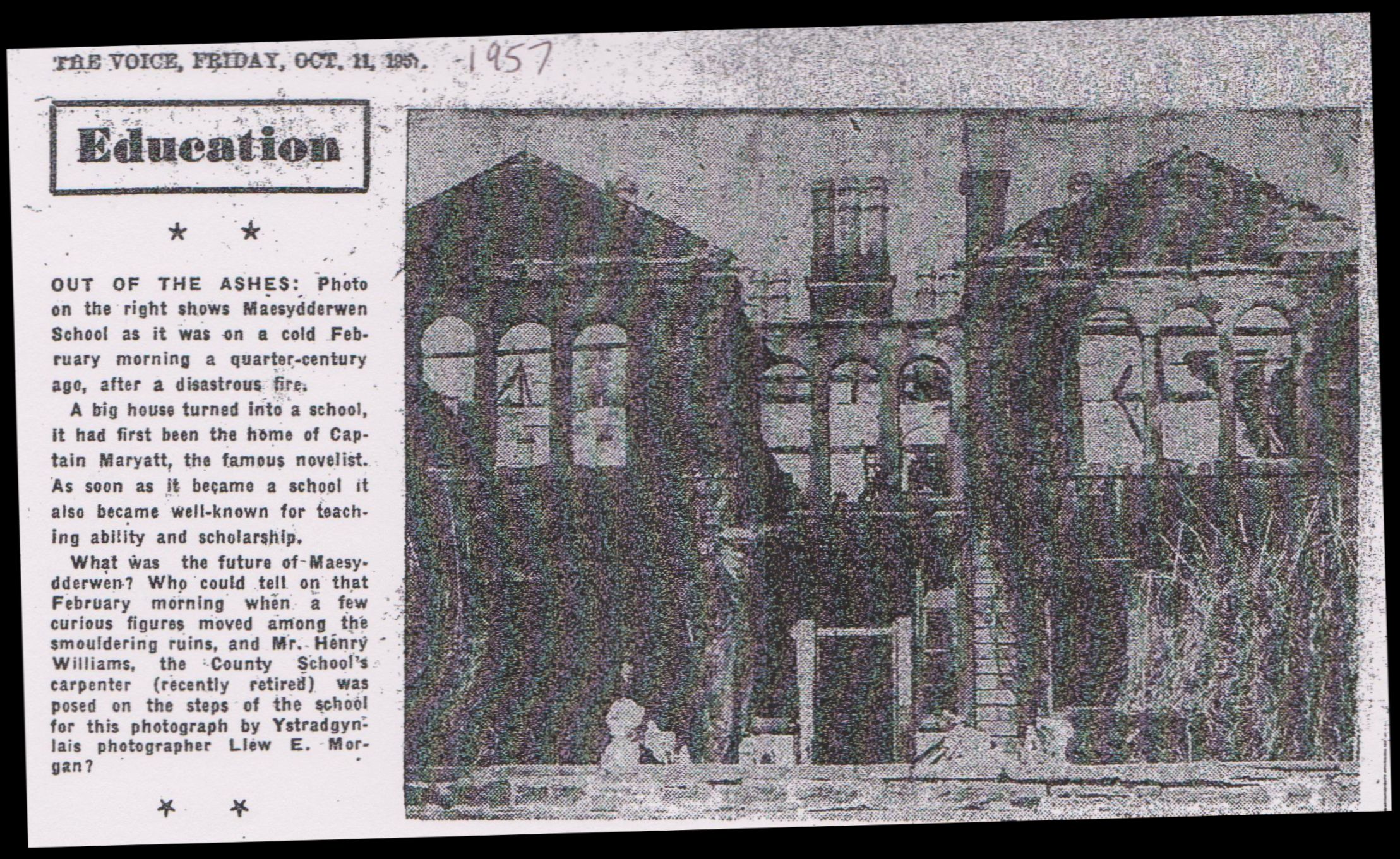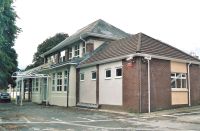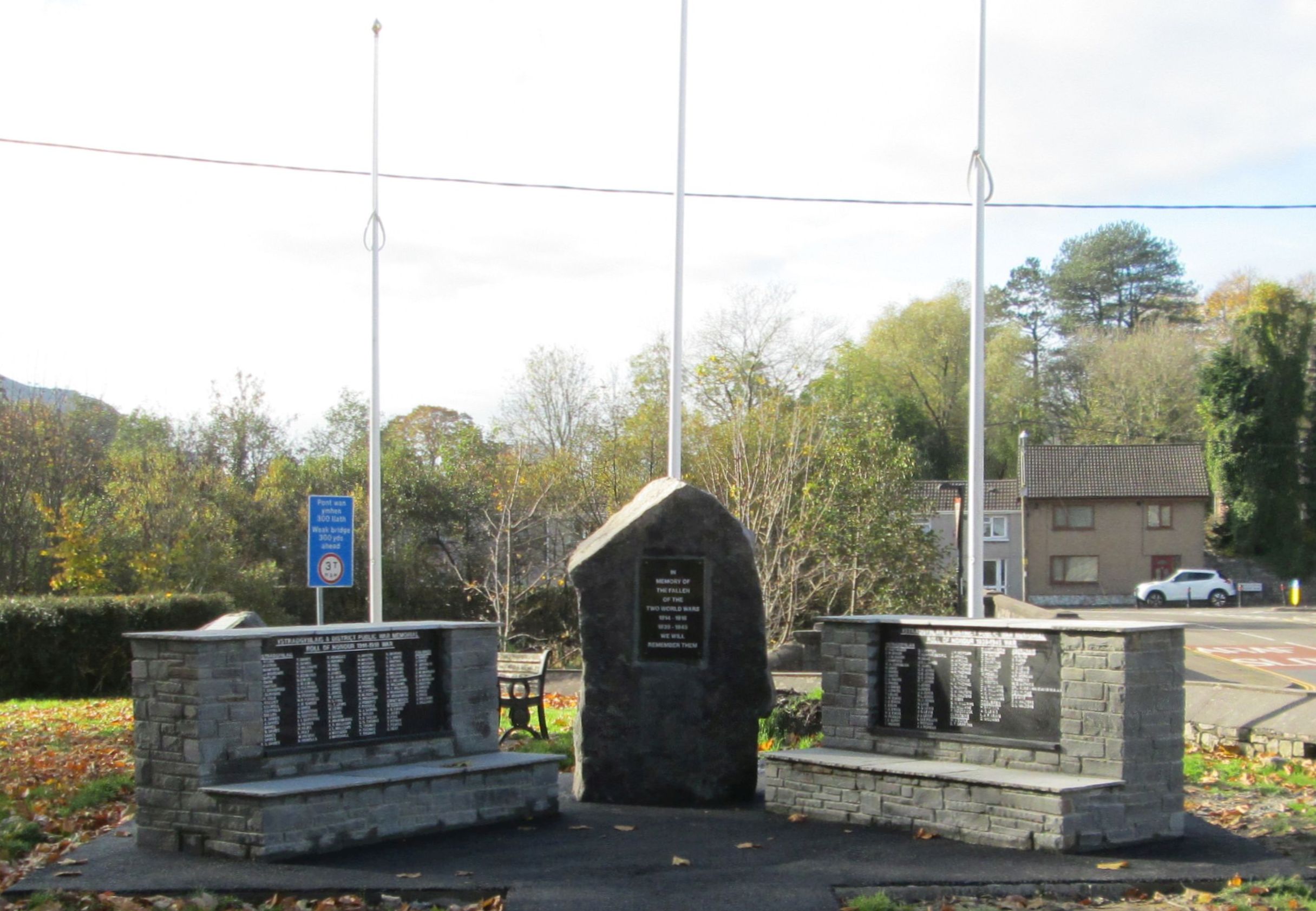Ystradgynlais & District
History and Heritage
50th Anniversary of Maesydderwen School
Maesydderwen Makes Men

The Photograph published in The Voice 11th October 1957 was headed:
OUT OF THE ASHES: Photo shows Maesydderwen School as it was on a cold February morning a quarter-century ago after a disastrous fire.
A big house turned into a school, it had first been the home of Captain Maryatt, the famous novelist. As soon as it became a school it also became well-known for teaching ability and scholarship.
What was the future of Maesydderwen? Who could tell on that February morning when a few curious figures moved among the smouldering ruins and Mr Henry Williams, the County Schools Carpenter, (recently retired) was posed on the steps of the school for this photograph by Ystradgynlais photographer Llew E Morgan?
The article below was written by D Watkin Morgan, President of the Cardiff Cymrodorion Society and Headmaster of Roath Park County Secondary School and an old pupil of Maesydderwen.
Has there been such a singularly memorable year in the history of Wales as that of 1907? 50 years ago saw Royal Charters granted to two of our most important cultural institutions, the National Museum at Cardiff and the National Library at Aberystwyth and in the same year a Welsh Department within the Board of Education established, as well as the formation of the Workers Education Association.
No wonder 1957 is such a notable anniversary and that Wales in general rejoices with jubilation and pride.
All these have had an important bearing on Ystradgynlais and district which will celebrate the Jubilee of Maesydderwen County School, now a Comprehensive one.
Before 1907, secondary education was the privilege of a few who either attended the Brecon or Ystalyfera County Schools.
Such a school was long overdue in the area. In fact, in a district where Nonconformity predominated and political thought ripened, people were alive to all educational matters. Also the struggle around the Education Act of 1870 and in particular that of 1902 was still fresh in their minds.
Little apathy existed in local and Parliamentary elections. Chapels have full congregations and the Sunday Schools together with the various cultural societies exercised a tremendous influence. In the collieries, the men discussed cultural subjects and current affairs stimulated by the Llais, Tarian y Gweithwr and the many denominational periodicals.
Ben Davies of Pantteg, a national poet and a distinguished preacher reviewed books, while R J Derfel a fine bard and scholar had contributed many articles to the local press. The Eisteddfod figured prominently in the social life of the inhabitants with promising poets such as Gwilym Wyn on the horizon.
Indeed 1907 can be claimed to be the culmination of events following the reports of the English Commissioners in 1846 on the state of education in Wales.
REPORT ROUSED MUCH LOCAL INDIGNATION
These Commissioners, with no knowledge of Welsh and entirely out of sympathy with the grand heritage of Wales, had made a frontal attack on the native language by deploring its use in schools. Their views aroused the intense indignation of local people.
Most people spoke Welsh and out of a population of 2885, 383 children attended either a Church or a Dissenter's school and 834 the Sunday Schools. Symons, one of the Commissioners, could not speak a word of Welsh and obtained most of his evidence from English people such as Moir Crane of the Yniscedwyn works.
In answer to one question put to him Crane replied "As master over 1200 people I am quite of the opinion that the state of Wales is worse than almost any part of the kingdom: if I have any strike or quarrel with the people, it is almost next to impossible to reason or talk with them, for they are so led by others that they will give up their own judgement entirely. I have never known people with less of a mind of their own when their interests are called into questions".
Such answers were resented vehemently but they convinced the Commissioners that the cause of the backwardness among the people was the ignorance of the English language: although Lingen another member of the Commission had to admit that the average Welshman had a better command of his own language then the corresponding Englishman had over his.
However, these reports gave further impetus to education in general despite the 'Welsh not' edict, the language survived. The 1870 Act encouraged education and by 1892 schools became free. But a few years before this day, a Departmental Committee had been set up by Parliament to enquire into the state of Higher and Intermediate Education in Wales. The result of this was the Welsh Intermediate Act of 1889 which gave powers to County Councils to found County Schools.
These well-established were supervised and examined by the Central Welsh Board created in 1896: the first school of this type appeared in Caernarfon in 1894.
THE FIRST HEADMASTER
In the meantime the University of Wales had, on 30th November 1893 received its Royal Charter. Much had been achieved in an incredibly short time after the "Treason of the Blue Books". So when Mr John Walter Jones accepted the headship of the newly found County School at Ystradgynlais in 1907, he had the honour and privilege of organising the school to meet the requirements of the Welsh Intermediate Act which had clearly outlined the studies such a school should pursue.
Among them, the natural sciences as well as applied sciences had been specified, together with Grammar School subjects. Mr Jones well versed in Welsh and Classics, however, based the curriculum largely on the academic level.
But during his early years as headmaster the report of the Bryce Commission appeared. This again recommended the inclusion of Technical subjects, and so, when the school moved into its new quarters at the Maesydderwen, once the home of Captain Maryatt the famous novelist, Mr Ernest Rees a young science graduate was appointed and the foundation of many of the sciences were firmly laid through his first class teaching ability and scholarship.
In 1917 when Mr John Walter Jones moved to Neath to take over the headship of that Grammar school, Mr Ernest Rees succeeded him as headmaster at Maesydderwen.
No headmaster, whosoever he may be, has so cherished a school as he did. Steeped in educational matters, he boldly carried on the fine tradition already established and at the same time welcomed new ideas. Neither industrial difficulties nor World War One deterred him from his determination to make the school one of the foremost in South Wales. No one knew better than he the tribulations of the war. Young lads in the middle of examinations in the summer term would tomorrow be in the forces.
Nevertheless, Maesydderwen carried on. With more children entering accommodation had become a problem. The Headmaster's study became the Sixth Form room.
Still it was a grand and stately building with an atmosphere rarely found in any school in the country.
THE OLD SCHOOL RUINED BY FIRE
Alas, on a Sunday evening in February 1932 a disastrous fire burnt down the building and many valuable records were destroyed. The Governors lost no time in planning a new school on the old site while the pupils occupied the Gurnos School.
When the new school opened at a later date the tradition remained the same but the building modern in architectural design, with accommodation for a wider curriculum had none of the grandeur of the stately mansion.
A few years afterwards, Mr Ernest Rees relinquished his headship and Mr Seth Owen took his place. Mr Owen, who first arrived at the school in the summer term of 1918 in a military uniform, was the senior English master. With an honours degree from Bangor University College, he soon gained the respect and admiration of his pupils.
His period of headship came to a sudden end when his health broke down and a local man Mr Alwyn Thomas the present Headmaster was promoted to his place after many years as an assistant at Bath and Aberdare.
To him fell the colossal task of converting the school into a Comprehensive one, thereby implementing the Butler Act of 1944 as far as secondary education was concerned. This Act provided secondary education for children of all aptitudes.
The principle of selecting children at the 11plus stage is now in dispute. Whether the Comprehensive School is the answer remains to be seen.
THE RESPONSIBILITY OF REDEDICATING THE SCHOOL
Mr Alwyn Thomas has successfully organised the timetable, a formidable task in any secondary school but almost a superhuman one in a Comprehensive School.
And today, Maesydderwen in its 50th year can look back on a varied and progressive history. To Mr Thomas and his staff falls the responsibility and opportunity to rededicate the school for the next 50 years.
The Act of 1944 is the greatest one the country has known since 1870. It has given great opportunities and helped us to preserve the ancient tongue of Britain; and here lies the challenge. Will Maesydderwen be a bulwark against the rising tide of materialism and will it save our grand heritage?
The answer is found in Mark VIII verse 36.
'Canys pa lesad i ddyn, os ennill yr holl fyd, a cholli ei enaid ei hun.'
What good is it for a man to gain the whole world, yet forfeit his soul?
On this great occasion, Hen fes wherever they may be salute the school in gratitude and pride for what Headmasters and teachers have done for them and wish a successful future to an institution which will in future receive every boy and girl in the area.
THE ONLY REFERRENCE TO MARYATT AND MAESYDDERWEN I could find is:
JOSEPH MARRYAT Born 1790: Son of Joseph MARRYATT ESQ. Retired from Joseph Marryat and Sons (q.v.) 01/05/1849. Appears subsequently as active in Welsh iron industry and as banker with Price, Marryat, which failed in 1866. 1861 census shows him at Ystradgynlais and describes him (aged 70) as 'Justice of the Peace, Banker in London and proprietor of an ironworks', born West Indies Grenada. London Gazette (1866) shows the assignment by Sir Charles Rugge Price and Joseph Marryat to assignees for the benefit of their creditors. Joseph Marryat and Sir Charles Price had developed the pre-existing Ynyscedwyn Ironworks under the name of the Ynyscedwyn Iron Company, floated on the Stock Exchange in 1864 and subject to sequential liquidations and restructurings in 1869, 1870 1877 and 1881.
Will of Joseph Marryat formerly of Maes-y-Dderwen Swansea Vale in County of Brecon but late of 61 Warwick Street who d. 24/09/1876, effects under £4000.
Thus on 15th October 1957 Maesydderwen celebrated
50 GLORIOUS YEARS
Hundreds of people packed the school hall at Maesydderwen on Tuesday night. There jubilant scenes as the familiar faces of the past met the stalwarts of today to celebrate the Jubilee year of this famous school.
There was Mr W Seth Owen, headmaster from 1937 - 1951 who declared: "I remember the time when I thought State Ships were dropping out of the sky!"
Sir J Tudor Thomas of Cardiff, one of the first boys at Maesydderwen, whose job it was to see that the weather records were accurate.
Mrs Dr Marion Henry Jones, the cheery Cwmtwrch lady now of Aberystwyth, who helped to give local people a clear picture of what went on in the early days of the school days when music lessons were held in the school kitchen because of a lack of accommodation.
Yet none could emulate the achievement of Mr Alwyn Thomas present headmaster of the school - now the first Comprehensive School to be established in the country.
Mr Thomas, who listened with great satisfaction throughout the night to the praises and gratitude showered upon Maesydderwen, was his usual modest self when he addressed a large gathering.
"The goal reached another milestone in its history," he said.
Grey hair shining, he went on slowly: "and when I look back along the road on which it has journeyed, I am filled with pride and admiration and humility that so much had been achieved in a short period of time. As we who are engaged in the School at the present time span the years of the Old College of 1907 to the Maesydderwen of 1957, we realise more than ever the extent of this glorious heritage into which we have entered and the enormous debt we owe to all those who preceded us.
<
We think of those pioneers of secondary education in the Ystradgynlais district, men like Rev Moelwyn Morgan and Hywel Walters - men of enterprise and vision - who in those early days beheld so clearly the land that was far off and so surely laid the foundations.
We think of those administrators who translated into reality the cold contents of official documents and administrative memoranda."
Mr Thomas, son of a miner and himself a former miner, said that he was proud to see Mr Leonard, who had been connected with education in the area from the outset, able to attend.
GUIDED THE SCHOOL FOR 35 YEARS
"We think of our School Governors and the chairman of the Governing Body over the years - men like the late Mr Idris Davies," he declared, "who guided the destinies of the School for over 35 years and who Maesydderwen and the success of its pupils, were always a source of pride and affection."
Mr Thomas pointed out that they always thought of the former headmasters like Mr J Walter Jones, who pioneered the way, Mr W Ernest Rees and Mr Seth Owen, whose loyal service and devotion to the School had contributed so much to its development.
No less a contribution was made by the staff of the School over the years. They had inspired in the pupils a passion for all that was best in life.
Then there were the old boys and girls of the School who, by their achievements in all walks of life brought credit and distinction both to themselves and their old School.
"We live in a rapidly changing world and the application of scientific discovery and invention changing the pattern of human life at an alarming rate," said Mr Thomas.
"The School faces the challenge of change and our survival, we are told, depends on our response to this challenge. The emphasis today is on science and technology but as we face the future, let it not be forgotten that alongside science and technology must go the greatest of all arts - the art of living together in a challenging world."
Education was in the "front rank" today, he said. There was an ever increasing body of informed opinion alive to its importance and eager to translate into reality the needs of a changing society.
THE CHALLENGE
Maesydderwen today was on the threshold of a new era and the high ideals and achievements of its past pupils and the contribution of all those who had served it so loyally during the years that had gone by, would surely inspire the generations of boys and girls who were at present passing through the school. And "those of us who are with them - to follow in their footsteps and to uphold those standards of scholarship and service which they held so dearly," he added.
"I conclude with a personal tribute to my former headmaster, Mr W E Rees," said the Comprehensive School headmaster. "Unfortunately, he is unable to be present with us this evening - and to his staff of the early 1920s without whose assistance and inspiration, I should not be speaking here this evening.
"My thanks are also extended to the County administration officers and the Governors for their guidance and support and to the staff of the School for their co-operation at all times."
He added: "I feel therefore that the future can be faced with faith and confidence and that the pupils of Maesydderwen will, in the years to come, prove worthy of their School and of their noble heritage."
All copyright remains with the original copyright holder, and all original research is copyright Val Trevallion, YEARGroup and is put online as a free community project.
You can contact the Ystradgynlais and Ystalyfera History and Heritage websites by emailing:
contact@ystradgynlais-history.co.uk
or Val Trevallion by emailing yeargroup@hotmail.co.uk.
Ystradgynlais - South Wales

Email Yeargroup:
yeargroup@hotmail.co.uk
Email Wolfian Design:
webdesign@wolfianpress.com


























